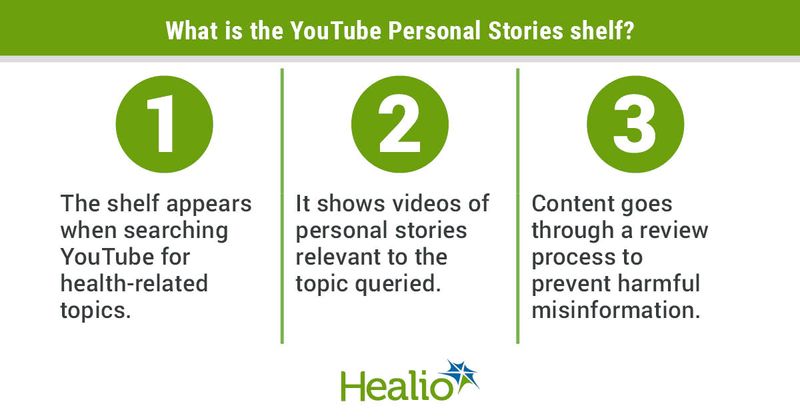YouTube Health adds section focused on personal experiences with cancer, other conditions
During office visits with patients, oncologists often must prioritize essential testing and treatment decision-making and are not always able to address patient concerns and questions that arise outside of the clinic.
“People trust their clinicians to give them the best medical advice, but the reality is that a physician’s opportunity to inform and educate their patients largely stops at the clinic door,” Nira Goren, MD, senior clinical lead at Google, told Healio. “So, what can be done for all the moments that matter in a patient’s health journey outside the clinic, which is the bulk of people’s lives?”

To help address these concerns and provide useful, relatable health information, YouTube Health has launched its Personal Stories shelf. This resource, content for which is vetted for medical accuracy by external experts, is based on the concept that patients do not consult YouTube solely for answers to straightforward medical questions, but also to answer the human question, “How do I live with this?”
Goren spoke with Healio about the potential value of YouTube Health as a means of bridging the potential gaps in care that may occur between clinic visits.
Healio: How did the Personal Stories shelf come to be?
Goren: I am a pediatrician by background, and I’ve always found great meaning in supporting families in helping their children thrive. The journey of parenthood is a 24/7 endeavor, and questions about your child’s health don’t stop at 5 p.m. — in fact, they often seem to peak at 3 a.m. So, the need to meet parents and caregivers where they are, with the information they need at the time they need it, initially inspired me to work on YouTube Health.
We’ve been spending a good deal of time trying to better understand why people come to our platform when they have these health questions. Not surprisingly, we learned that people want to understand complex medical issues in simple, visual terms. To address this, we launched our health product features last year. These videos feature content from authoritative health sources like hospitals, universities and local health authorities. Over the past year, we’ve expanded our partnerships with leading health organizations like Mass General Brigham and the American Public Health Association, as well as with clinicians and creators, to further increase the accessibility of high-quality health content.
Interestingly, however, we saw a less expected pattern in the data — often, people weren’t coming to YouTube Health with medical questions so much as human questions. They have a diagnosis and — especially if it is a chronic condition — they want to know how others live with the condition or how they can support their loved one who has the condition.
This need for connection and belonging is so universal, and data has shown that peer support and social connectedness positively impacts both physical and mental health. There are different support groups available for this, and that is very important, but YouTube Health can be complementary to that. It can meet those patients where they are at any moment of the day, which is meaningful. That’s why we launched the Personal Stories shelf, which shows a personal story that is relevant to the topic that’s been queried.
Healio: How is information vetted for the Personal Stories shelf?
Goren: We identify content that is focused on personal lived experiences, and in order to make sure the content doesn’t contain harmful misinformation, it goes through a review process. We want to highlight supportive content, but we also want to be sure there are no messages in that content that could be harmful to the user.
The videos are already being created organically and uploaded onto YouTube. These shelves identify that personal, authentic content. They ensure that that this content can be more discoverable for a user looking for that information in the moment.
In terms of mis- and disinformation, we think of it as a garden. It’s incredibly important to pull out the weeds, but it’s equally important to plant and water the seeds that you want to grow. We need both of these to occur if we want a healthy information ecosystem. We want to identify the content that is valid, accessible and authentic, and provide contextual cues so that users looking for that information can find it and feel supported and empowered by it.
As far as pulling out the weeds, all our content is subject to a mixture of human and machine-learning review. We also have various policies in place to avoid misinformation and disinformation. For example, last fall we announced an expansion of our medical misinformation policy to cover all currently administered vaccines. So, it’s not just a one-angle approach. It has to be a holistic approach to providing support and accurate information.
Healio: How can physicians use YouTube Health’s Personal Stories shelf to enhance communication and connection with patients?
Goren: The power of YouTube Health is that it can be a synergistic, complementary tool in the physician’s toolkit to empower patients on their health journey outside the clinic. Patients might forget what they heard at the doctor’s office, or questions might occur to them in between visits to the clinic. Traditionally, a doctor might give a patient a pamphlet with information about their condition. With YouTube Health, it’s as though the pamphlet has come to life. It harnesses the power of video to make these messages more relatable than traditional text pamphlets.
Healio: Is there anything else you’d like to mention?
Goren: The work we did on Personal Stories was inspired by our colleague, Maya Amoils, who received a diagnosis of stage IV ovarian cancer in her 20s. She was an incredible champion who guided this work and spoke a lot about trying to find support from other women who had been through a similar experience. A foundation has been established in her name and can be accessed online at integrativemedfoundation.org/mayas-way.

